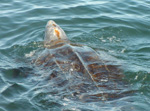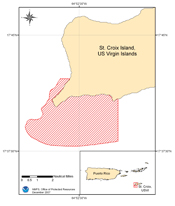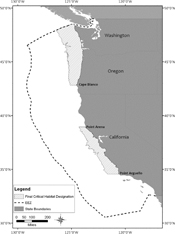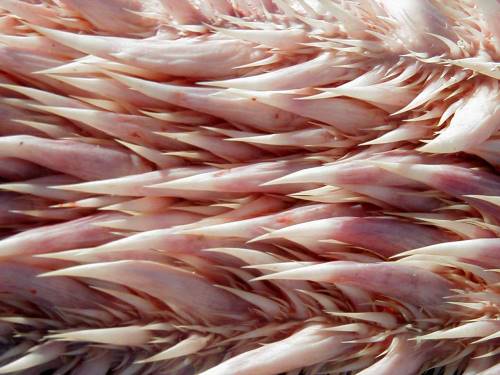Leatherback Turtle (Dermochelys coriacea)
Status | Taxonomy | Species Description | Habitat | Distribution |
Population Trends | Threats | Conservation Efforts | Regulatory Overview |
Key Documents | More Info
| Photos
 Leatherback turtle (Dermochelys coriacea) Photo: Scott R. Benson, NMFS Southwest Fisheries Science Center |
|||
|
Did You Know? · NMFS announces 12-month finding on petition to revise leatherback critical habitat in Puerto Rico |
||
|
|||
Status
ESA Endangered - throughout its range
Taxonomy
Kingdom: Animalia
Phylum: Chordata
Class: Reptilia
Order: Testudines
Family: Dermochelyidae
Genus: Dermochelys
Species: coriacea
| Weight: | 2,000 pounds (900 kg) for adults; hatchlings are 40-50 grams (1.5-2 ounces) |
| Length: | 6.5 feet (2 m) for adults; hatchlings are 2-3 inches (50-75 cm) |
| Appearance: | primarily black with pinkish-white coloring on their abdomen (ventrally) |
| Lifespan: | unknown |
| Diet: | soft-bodied animals, such as jellyfish and salps |
| Behavior: | females lay clutches of approximately 100 eggs several times during a nesting season, typically at 8-12 day intervals |
The leatherback is the largest turtle--and the largest living reptile--in the world.
The leatherback is the only sea turtle that lacks a hard, bony shell. A leatherback's top shell (carapace) is approximately 1.5 inches (4 cm) thick and consists of leathery, oil-saturated connective tissue overlaying loosely interlocking dermal bones. The carapace has seven longitudinal ridges and tapers to a blunt point.
The front flippers lack both claws and scales and are proportionally longer than in other sea turtles; their back flippers are paddle-shaped. The ridged carapace and large flippers are characteristics that make the leatherback uniquely equipped for long distance foraging migrations.
Female leatherbacks lay clutches of approximately 100 eggs on sandy, tropical beaches. Females nest several times during a nesting season, typically at 8-12 day intervals. After 60-65 days, leatherback hatchlings emerge from the nest with white striping along the ridges of their backs and on the margins of the flippers.
Leatherbacks lack the crushing chewing plates characteristic of sea turtles that feed on hard-bodied prey (Pritchard 1971). Instead, they have pointed tooth-like cusps and sharp edged jaws that are perfectly adapted for a diet of soft-bodied pelagic (open ocean) prey, such as jellyfish and salps. A leatherback's mouth and throat also have backward-pointing spines that help retain such gelatinous prey.
Habitat
Leatherbacks are commonly known as pelagic (open ocean) animals, but they also forage in coastal waters. In fact, leatherbacks are the most migratory and wide ranging of sea turtle species.
Thermoregulatory adaptations such as a counter-current heat exchange system, high oil content, and large body size allow them to maintain a core body temperature higher than that of the surrounding water, thereby allowing them to tolerate colder water temperatures.
Nesting female leatherbacks tagged in French Guiana have been found along the east coast of North America as far north as Newfoundland. Atlantic Canada supports one of the largest seasonal foraging populations of leatherbacks in the Atlantic. Leatherbacks tagged with satellite transmitters at sea off Nova Scotia were tracked to waters adjacent to nesting beaches along the northeast coast of South American, the Antilles, Panama and Costa Rica (James et al., 2005).
Leatherbacks mate in the waters adjacent to nesting beaches and along migratory corridors. After nesting, female leatherbacks migrate from tropical waters to more temperate latitudes, which support high densities of jellyfish prey in the summer.
 Leatherback Turtle U.S. Virgin Islands Critical Habitat (click for larger view PDF)  Leatherback Turtle U.S. West Coast Critical Habitat (click for larger view JPG)  Leatherback Range Map (click for larger view PDF) |
Critical Habitat
U.S. Virgin Islands
In 1979, we designated critical habitat for leatherback turtles to include the coastal waters adjacent to Sandy Point, St. Croix, U.S. Virgin Islands.
U.S. West Coast
In 2007, we received a petition to revise the leatherback critical habitat designation to include waters off the U.S. West Coast [pdf]. We published a 90-day finding on the petition [pdf] in December 2007.
Then, on January 5, 2010, we published a proposed rule [pdf] to revise the critical habitat designation. NMFS announced the designation of additional critical habitat to provide protection for endangered leatherback sea turtles along the U.S. West Coast on January 20, 2012, per a court settlement agreement, and the regulation formally published in the Federal Register on January 26, 2012 (77 FR 4170).
Puerto Rico
On February 2, 2010, the Sierra Club petitioned [pdf] us to revise the critical habitat designation for leatherback sea turtles to include waters adjacent to a major nesting beach in Puerto Rico. We published a 90-day finding on the petition [pdf] on July 16, 2010, which found the petition did not present substantial scientific information indicating that the petitioned action may be warranted for leatherback sea turtles.
The Sierra Club submitted a new petition [pdf] on November 2, 2010 to revise the critical habitat designation to again include waters in Puerto Rico. On August 4, 2011, NMFS and FWS published a 90-day finding and 12-month determination (76 FR 47133) on the petition to revise critical habitat.
Distribution
Leatherback turtle nesting grounds are located around the world, with the largest remaining nesting assemblages found on the coasts of northern South America and west Africa. The U.S. Caribbean, primarily Puerto Rico and the U.S. Virgin Islands, and southeast Florida support minor nesting colonies, but represent the most significant nesting activity within the United States. Adult leatherbacks are capable of tolerating a wide range of water temperatures, and have been sighted along the entire continental coast of the United States as far north as the Gulf of Maine and south to Puerto Rico, the U.S. Virgin Islands, and into the Gulf of Mexico.
The distribution and developmental habitats of juvenile leatherbacks are poorly understood. In an analysis of available sightings (Eckert 2002), researchers found that leatherback turtles smaller than 100 cm carapace length were only sighted in waters 26°C or warmer, while adults were found in waters as cold as 0 to 15°C off Newfoundland (Goff and Lean 1988).
 Videos: Leatherback Turtles in the Pacific Ocean NMFS Southwest Fisheries Science Center  Videos: Leatherback Turtles in the Solomon Islands NMFS Southwest Fisheries Science Center |
Population Trends
The Pacific Ocean leatherback population is generally smaller in size than that in the Atlantic Ocean. Because adult female leatherbacks frequently nest on different beaches, nesting population estimates and trends are especially difficult to monitor. In the Pacific, the IUCN ![]() notes that most leatherback nesting populations have declined more than 80%. In other areas of the leatherback's range, observed declines in nesting populations are not as severe, and some population trends are increasing or stable. In the Atlantic, available information indicates that the largest leatherback nesting population occurs in French Guyana, but the trends are unclear. Some Caribbean nesting populations appear to be increasing, but these populations are very small when compared to those that nested in the Pacific less than 10 years ago. Nesting trends on U.S. beaches have been increasing in recent years.
notes that most leatherback nesting populations have declined more than 80%. In other areas of the leatherback's range, observed declines in nesting populations are not as severe, and some population trends are increasing or stable. In the Atlantic, available information indicates that the largest leatherback nesting population occurs in French Guyana, but the trends are unclear. Some Caribbean nesting populations appear to be increasing, but these populations are very small when compared to those that nested in the Pacific less than 10 years ago. Nesting trends on U.S. beaches have been increasing in recent years.
- harvest of eggs and nesting females
- incidental capture in fishing gear
- general threats to marine turtles
Leatherback turtles face threats on both nesting beaches and in the marine environment. The greatest causes of decline and the continuing primary threats to leatherbacks worldwide are long-term harvest and incidental capture in fishing gear. Harvest of eggs and adults occurs on nesting beaches while juveniles and adults are harvested on feeding grounds. Incidental capture primarily occurs in gillnets, but also in trawls, traps and pots, longlines, and dredges. Together these threats are serious ongoing sources of mortality that adversely affect the species' recovery.
 |
| Leatherback turtle hatchling (Dermochelys coriacea) Photo: S.R. Livingstone, University of Glasgow |
For more information, please visit our threats to marine turtles page.
Conservation Efforts
Because leatherbacks are highly pelagic animals and make long migrations, they come into contact with people of many nations. Therefore, conservation efforts for leatherback populations in one country may be jeopardized by activities in another. Protecting leatherback turtles on U.S. nesting beaches and in U.S. waters alone, therefore, is not sufficient to ensure the continued existence of the species.
Leatherback turtles are protected by various international treaties and agreements as well as national laws. They are listed in Appendix I of the Convention on International Trade in Endangered Species of Wild Flora and Fauna (CITES), which means that international trade of this species is prohibited. Leatherbacks are listed in Appendices I and II of the Convention on Migratory Species (CMS ![]() ) and are protected under the following auspices of CMS: the Memorandum of Understanding on the Conservation and Management of Marine Turtles and their Habitats of the Indian Ocean and South-East Asia (IOSEA) and the Memorandum of Understanding Concerning Conservation Measures for Marine Turtles of the Atlantic Coast of Africa. Leatherbacks are protected under Annex II of the Specially Protected Areas and Wildlife (SPAW
) and are protected under the following auspices of CMS: the Memorandum of Understanding on the Conservation and Management of Marine Turtles and their Habitats of the Indian Ocean and South-East Asia (IOSEA) and the Memorandum of Understanding Concerning Conservation Measures for Marine Turtles of the Atlantic Coast of Africa. Leatherbacks are protected under Annex II of the Specially Protected Areas and Wildlife (SPAW ![]() ) Protocol of the Cartagena Convention. The U.S. is a party of the Inter-American Convention for the Protection and Conservation of Sea Turtles (IAC), which is the only international treaty dedicated exclusively to marine turtles.
) Protocol of the Cartagena Convention. The U.S. is a party of the Inter-American Convention for the Protection and Conservation of Sea Turtles (IAC), which is the only international treaty dedicated exclusively to marine turtles.
 Leatherback turtle (Dermochelys coriacea) Photo: Scott R. Benson, NMFS Southwest Fisheries Science Center |
In the U.S., NOAA Fisheries and the U.S. Fish and Wildlife Service (USFWS) have joint jurisdiction for leatherback turtles, with NOAA having the lead in the marine environment and USFWS having the lead on the nesting beaches. Both federal agencies, and a number of state agencies, have promulgated regulations to eliminate or reduce threats to sea turtles. In the Atlantic and Gulf of Mexico, we has required measures (for example, gear modifications, changes to fishing practices, and time/area closures) to reduce sea turtle bycatch in pelagic longline, mid-Atlantic gillnet, Chesapeake Bay pound net, and southeast shrimp and flounder trawl fisheries.
We have worked closely with the shrimp trawl fishing industry to develop turtle excluder devices (TEDs) to reduce the mortality of sea turtles incidentally captured in shrimp trawl gear. TEDs that are large enough to exclude leatherback turtles are now required in shrimp trawl nets. Since 1989, the U.S. has prohibited the importation of shrimp harvested in a manner that adversely affects sea turtles. The import ban does not apply to nations that have adopted sea turtle protection programs comparable to that of the U.S. (i.e., require and enforce the use of TEDs) or to nations where incidental capture in shrimp fisheries does not present a threat to sea turtles (for example, nations that fish for shrimp in areas where sea turtles do not occur). The U.S. Department of State (DOS) is the principal implementing agency of this law, while we serve as technical advisor. We provide extensive TED training throughout the world.
 Video: Leatherback Turtles- Pacific Upwelling & Jellyfish NMFS Southwest Fisheries Science Center |
In 2003, we developed the Strategy for Sea Turtle Conservation and Recovery in Relation to Atlantic and Gulf of Mexico Fisheries (Strategy) to evaluate and address domestic sea turtle bycatch comprehensively across jurisdictional (i.e., state and Federal) and fishing sector (i.e., commercial and recreational) boundaries on a per-gear basis in fisheries of the Atlantic and Gulf of Mexico.
We are currently involved in cooperative gear research projects designed to reduce sea turtle bycatch in the Gulf of Mexico and Atlantic pelagic longline fisheries, the Hawaii-based deep set longline fishery, the Atlantic sea scallop dredge fishery, the Chesapeake Bay pound net fishery, and non-shrimp trawl fisheries in the Atlantic and Gulf.
 Leatherback turtle esophagus (Dermochelys coriacea) Photo: Karumbé, Sea Turtles of Uruguay |
Regulatory Overview
The leatherback turtle was listed under the Endangered Species Act as endangered in 1970.
In 1992, we finalized regulations to require TEDs in shrimp trawl fisheries to reduce interactions between turtles and trawl gear. Since then, we have modified these regulations as new information became available on increasing the efficiency of TEDs (for example, larger TEDs are now required to exclude larger turtles).
We initially designated critical habitat in 1998 for leatherback turtles to include the coastal waters adjacent to Sandy Point, St. Croix, U.S. Virgin Islands. In 2007, we received a petition to revise the critical habitat designation [pdf]. we published a 90-day finding on the petition [pdf] in December 2007. In 2009, we proposed to revise the critical habitat to include areas off of the U.S. west coast.
We implement measures to reduce sea turtle interactions in fisheries by regulations and permits under the ESA and Magnuson-Stevens Fishery Conservation and Management Act. Since the early 1990s,we have implemented sea turtle conservation measures including, but not limited to, TEDs in trawl fisheries, large circle hooks in longline fisheries, time and area closures for gillnets, and modifications to pound net leaders. Click here for a list of our regulations to protect marine turtles.
Key Documents
(All documents are in PDF format.)
| Title | Federal Register | Date |
|---|---|---|
NMFS Initiates 5-year reviews of four sea turtles (Kemp's ridley, olive ridley, leatherback, and hawksbill)
|
77 FR 61573 | 10/10/2012 |
Critical habitat designated for endangered leatherback sea turtles along the U.S. West Coast |
77 FR 4170 | 01/26/2012 |
Sierra Club Re-Petition to NMFS to revise the critical habitat designation to include waters adjacent to a major nesting beach in Puerto Rico
|
n/a 77 FR 32909 76 FR 25660 |
11/02/2010 06/04/2012 05/05/2011 |
| Sierra Club petition to NMFS and USFWS to revise the critical habitat designation to include nesting beach habitat and waters adjacent to the nesting beach in Puerto Rico | n/a | 02/22/2010 |
|
75 FR 41436 | 07/16/2010 |
|
76 FR 47133 | 08/04/2011 |
Proposed Rule to Revise Critical Habitat Designation |
75 FR 319 75 FR 7434 75 FR 5015 |
01/05/2010 02/19/2010 02/01/2010 |
Petition to Revise the Critical Habitat Designation for the Leatherback Sea Turtle
|
n/a 72 FR 73745 |
09/26/2007 12/28/2007 |
| 5-Year Review | n/a | 08/31/2007 |
| Virginia Pound Net Fishery Regulations | 71 FR 36024 | 06/23/2006 |
| Recovery Plan - U.S. Pacific | 63 FR 28359 | 05/22/1998 |
| Status Review of Sea Turtles Listed Under the Endangered Species Act of 1973 | 61 FR 17 | 01/02/1996 |
| TED Regulations for Shrimp Trawls | 57 FR 57348 | 12/04/1992 |
| Recovery Plan - U.S. Caribbean, Atlantic, and Gulf of Mexico | n/a | 10/29/1991 |
| Critical Habitat - Sandy Point, St. Croix, U.S. Virgin Islands | 44 FR 17710 | 03/23/1979 |
|
43 FR 12050 | 03/23/1978 |
| ESA Listing Rule | 35 FR 8491 | 06/02/1970 |
- Kids' Times: Leatherback Sea Turtle [pdf]
- Videos of Leatherback Turtles from Southwest Fisheries Science Center
- Sea Turtle Recovery Planning
- NOAA's National Marine Sanctuaries Encyclopedia
- U.S. Fish and Wildlife Service Leatherback Turtle Species Profile
- Marine Turtle Related Links
Literature Cited
- Eckert, S.A. 2002. Distribution of juvenile leatherback sea turtle, Dermochelys coriacea, sightings. Marine Ecology Progress Series 230: 289-293.
- Goff, G.P. and J. Lien. 1988. Atlantic leatherback turtles (Dermochelys coriacea) in cold water off Newfoundland and Labrador. Canadian Field Naturalist 102 (1):1-5.
- James, M.C., C.A. Ottensmeyer and R.A. Myers. 2005. Identification of high-use habitat and threats to leatherback sea turtles in northern waters: new directions for conservation. Ecology Letters 2005(8):195-201.
Updated: October 12, 2012

